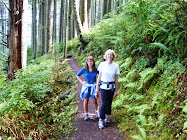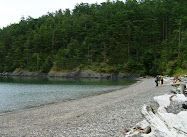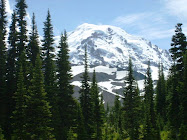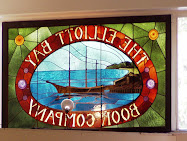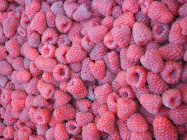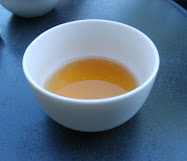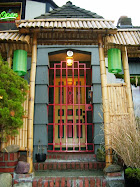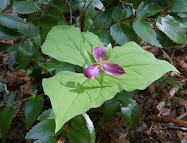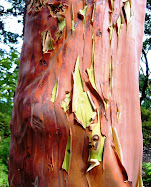 This is the first of a few posts from Southeast Alaska, which is just a quick jet trip north up the coast from the Pacific Northwest and shares with us an ocean, northern latitude, similar flora and fauna, and a spirited outdoors culture.
This is the first of a few posts from Southeast Alaska, which is just a quick jet trip north up the coast from the Pacific Northwest and shares with us an ocean, northern latitude, similar flora and fauna, and a spirited outdoors culture.I didn’t arrive in Sitka this morning with an agenda, but as soon as I see the cluster of small islands just offshore as we drive the short trip to town from the airport, I’m seized with desire. I must kayak out there.
It’s a drizzly, gray day, and low clouds obscure the surrounding mountains (most notably Mount Edgecumbe). But on the upside, the water is placid and no one else is out except a few trawlers.
 As soon as I drop my luggage at the hotel, I ask where to rent kayaks and a friendly local sends me over to Sitka Sound Ocean Adventures at the Crescent Harbor marina, about a 10-minute walk away.
As soon as I drop my luggage at the hotel, I ask where to rent kayaks and a friendly local sends me over to Sitka Sound Ocean Adventures at the Crescent Harbor marina, about a 10-minute walk away. I find the old blue school bus with a kayak propped in front in the parking lot and ask the fresh-scrubbed young woman outside, “I’d like to go kayaking this afternoon, can I rent or join a group that’s going out?”
“No one else is signed up, but you can go with a guide, “ she replies with a smile. “The water is so calm now, can you go soon?”

Most definitely. I dash a couple blocks into town to grab a quick lunch at Two Chicks in the Window, a local seafood stand recommended by the guide service. Ten thumbs up to this spot. Today’s special is white king salmon on grilled rosemary bread with spicy coleslaw. The flaked fresh fish, topped with a red pepper aioli and spring greens, is so sweet and tender that I chow it down quickly. Divine.
Lucky me, they managed to find two single kayaks for my harbor outing rather than a double. My friendly guide Mitchell is a handsome Vermont transplant who has been bouncing around for several years living the footloose outdoorsy life I wish I’d done in my twenties.
After getting all rigged up, we shove off a boat launch into the smooth green water and immediately head out towards the islands I saw earlier. It feels great to find that rhythmic, push-pull paddling cadence, and we move quickly across the forest-fringed harbor out to the small islands.

Along the rocky shoreline of Aleutski Island, which reminds me a lot of Washington’s San Juans Islands, neon orange and deep purple starfish cling to rocks beneath the clear water surface among plump green-yellow rockweed and dappled ribbon kelp.
“See that lighthouse out there?” says Mitchell, pointing about a half mile away. “Let’s head toward that.”

We pass more petite islands topped with thick evergreen trees and draw close to the tall white structure, which isn’t actually a functioning lighthouse. Mitchell tells me it was built by a quirky local veterinarian, who only made people pay for his services if he didn’t like their pets.

Since I’m a decent paddler and we’re making good time, Mitchell suggests that next we head for a couple narrow islands another half mile farther towards the open ocean. By this time we’re both damp from the light, steady rain, but it doesn’t bother either of us.
“On the other side of those islands, there’s nothing between us and Eurasia,” he tells me. I’m game.

A breeze picks up as we get close to the inland side of the islands. Atop one of the windblown trees is a big immature bald eagle, whose head is still dark on top. We draw close and linger for a minute, where the water is still.
“I could float here for a long time and just be with the Zen of the moment,” says Mitchell, who has revealed the soul of an artist. I know what he means. I wish we could just hang here for a while and listen to the wind in the trees and water lapping against the rocks.

To our left is a small gap between the island and a rocky shoal where ocean waves are breaking in foamy white splashes. Mitchell tells me to stay in the middle of the tight channel, and we paddle quickly through and around to the outside.
“Look over to the right,” Mitchell says. “There’s an old World War II bunker.” Perched on the rocks facing the ocean is an gray, forlorn-looking concrete structure. I sure wouldn't want to spend a winter there.

What a contrast to the inner harbor. Big ocean swells roll in and break on the weathered, rocky shoreline and then bounce back toward us. Our kayaks bob up and down several feet in the choppy, rolling water. It feels exactly like air swells on the flight this morning up from Seattle.

Unfortunately there’s a time limit to this sweet sojourn, and we need to head back. As we’re approaching the end of the Sitka Airport runway, an Alaska Airlines jet takes off and roars not far overhead. And soon we’re back on land.

Afterwards I chat a bit with Alison Dunlap, who owns Sitka Sound Ocean Adventures with her husband John. I’m probing her for some colorful quotes about kayaking in Sitka. “Many shades of gray,” she laughs.
Come to think of it, I’m drawn to many shades of gray myself. (Just look at my wardrobe for starters.) Sure, I wouldn’t mind blue skies and sunshine, but the gray and rain today also made the trip more special. It was just me and Mitchell, the bald eagles and ravens, and the beautiful island-strewn harbor all to ourselves.
When You Go

Sitka Sound Ocean Adventures runs daily tours, from a 2.5-hour harbor tour, which I did, to half day and more. I was just lucky to be the only customer on a rainy day, so I got a private tour. My trip was $73 with tax. Alison says they can arrange multi-day expeditions or rent gear for those wanting to take a longer trip.












































